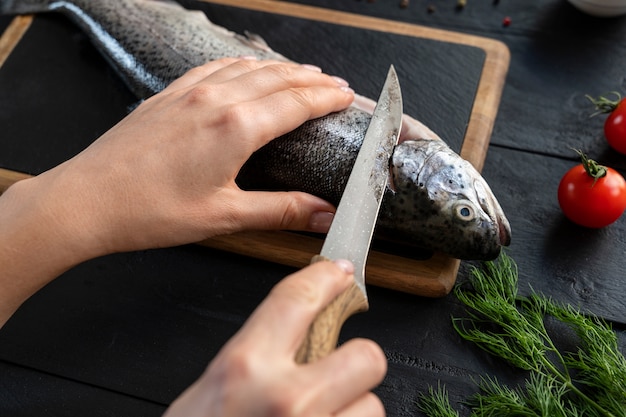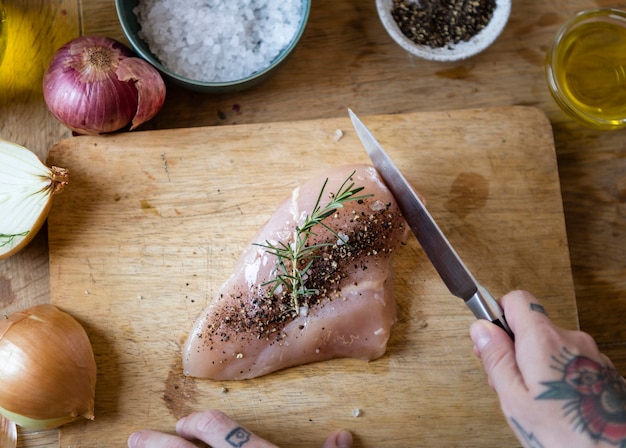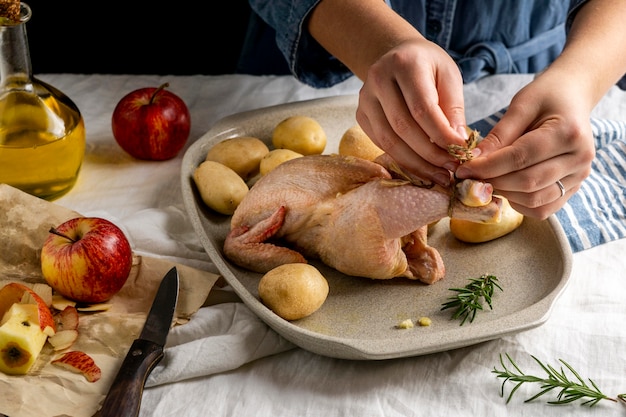Ah, haddock. A fish that conjures up memories of seaside holidays, the tang of salt air, and the simple pleasure of a perfectly cooked meal. There’s a comforting familiarity to haddock, a firm, flaky white fish that’s incredibly versatile and easy to cook. Whether you prefer it pan-fried, baked, or grilled, haddock always delivers a delicious meal. This article is your ultimate guide to cooking haddock like a pro. We’ll cover everything from selecting the best haddock to different cooking methods, plus some of my favourite recipes. We’ll even tackle some common questions about this versatile fish. So, grab your apron and let’s dive in!
(Part 1) Choosing the Right Haddock

The first step to cooking delicious haddock is selecting the right fish. Here’s what to look for:
Fresh vs Frozen
Fresh and frozen haddock both have their merits. If you can get your hands on fresh haddock, go for it! Look for fish with bright, shiny eyes, firm flesh, and a fresh, slightly salty scent. The flesh should spring back when pressed gently. But don’t dismiss frozen haddock. It's often a convenient and affordable option, especially if fresh isn’t readily available. Just make sure the package is properly sealed and hasn't been thawed and refrozen. Frozen haddock will be firm to the touch and should have a solid, icy feel.
Whole vs Fillet
You can buy haddock whole, but most people opt for fillets. Fillets are pre-cut pieces of fish, making them much easier to prepare and cook. whole haddock requires a bit more effort, but it can be a rewarding experience if you're up for the challenge. It allows you to make the most of the fish, utilizing the bones for stock or even using the head for a hearty fish soup.
Size Matters
The size of the haddock you choose will depend on how you plan to cook it. For pan-frying, smaller fillets are ideal, cooking more quickly and evenly. Larger fillets are perfect for baking or grilling, providing more substantial servings. For a family meal, you'll probably need a couple of fillets per person, depending on their size.
Skin On or Skin Off
Whether you choose haddock with skin on or skin off is a matter of preference. Skin-on haddock will help keep the fish moist while cooking. The skin acts as a protective barrier, preventing the fish from drying out. If you're using skin-on fillets, you'll need to score the skin with a sharp knife before cooking to prevent it from curling up. This allows the fat to render and provides a crispy, flavorful exterior. Skinless fillets are perfectly fine and are often easier to handle. They can be slightly more prone to drying out, so be mindful of cooking times. Personally, I prefer skin-on fillets, as I find the texture and flavor to be superior. But ultimately, it’s up to you!
(Part 2) Preparing Your Haddock

Once you've got your haddock, it's time to prepare it for cooking. Here’s a simple step-by-step guide:
- Pat Dry: Whether you're using fresh or frozen haddock, pat the fillets dry with kitchen paper. This helps to prevent the fish from sticking to the pan and ensures it cooks evenly.
- Season: Salt and pepper are essential seasonings for haddock, enhancing its natural flavour. You can also add other spices, herbs, or citrus juice to create different flavour profiles. For example, I love adding a pinch of smoked paprika and a squeeze of lemon juice to my haddock. This adds a subtle smokiness and tangy brightness.
- Marinate: If you have time, marinating the haddock can add depth of flavour. A simple marinade of olive oil, lemon juice, and fresh herbs like dill or parsley is perfect for haddock. You can also experiment with more adventurous marinades, such as soy sauce, ginger, and garlic for a more Asian-inspired flavour.
- Flour or Breadcrumbs: If you're pan-frying or baking your haddock, you can coat it in flour or breadcrumbs to create a crispy exterior. This helps to lock in the moisture and adds a satisfying texture. For a classic approach, use plain flour. For a more robust flavour, try seasoned breadcrumbs or even crushed nuts like almonds or pistachios.
(Part 3) How to Cook Haddock

Haddock is a versatile fish that can be cooked in many different ways. Here are a few of my favourite methods:
Pan-frying
Pan-frying is a quick and easy way to cook haddock, perfect for a weeknight meal. Here’s how to do it:
- Heat a tablespoon of olive oil in a non-stick pan over medium heat. A good quality olive oil will impart a subtle but delicious flavour to the fish.
- Add the seasoned haddock fillets to the hot pan and cook for about 3-4 minutes per side, or until golden brown and cooked through. Don't overcrowd the pan - cook the fillets in batches if necessary. This ensures even cooking and prevents the fish from steaming instead of frying.
- For a crispy exterior, turn the heat down slightly towards the end of cooking and allow the fillets to cook for a few extra minutes, undisturbed. This helps to achieve a beautiful, golden-brown crust.
Baking
Baking is a great way to cook haddock if you're looking for a healthier option. Here's how:
- Preheat your oven to 180°C (350°F).
- Place the seasoned haddock fillets on a baking sheet lined with parchment paper. This prevents the fish from sticking and makes for easy cleanup.
- For a more flavorful bake, drizzle the fillets with olive oil and add aromatics such as lemon slices, garlic cloves, or herbs like thyme or rosemary.
- Bake for about 15-20 minutes, or until the fish is cooked through and flakes easily with a fork.
Grilling
Grilling is a great way to add a smoky flavour to haddock, perfect for summer evenings. Here’s how:
- Preheat your grill to medium heat. Make sure the grill grates are clean and lightly oiled to prevent sticking.
- Lightly oil the haddock fillets and season them with salt, pepper, and any other desired spices.
- Grill for about 4-5 minutes per side, or until the fish is cooked through and has grill marks. For a more intense smoky flavour, try grilling over charcoal instead of gas.
- If you’re using a gas grill, keep the lid closed while grilling to allow the heat to circulate evenly.
(Part 4) Delicious haddock recipes
Now, for the fun part - the recipes! Here are a few of my favourite ways to cook haddock:
pan-fried haddock with Lemon and Dill
This is a simple and classic recipe that's perfect for a weeknight meal.
- Season the haddock fillets with salt, pepper, and a squeeze of lemon juice. The tangy lemon juice helps to brighten the flavour of the fish.
- Heat a tablespoon of olive oil in a non-stick pan over medium heat.
- Add the fillets to the pan and cook for 3-4 minutes per side, or until golden brown and cooked through.
- Garnish with fresh dill and serve with lemon wedges. The fresh dill adds a herbaceous fragrance and complements the lemon perfectly.
baked haddock with Garlic and Herbs
This recipe is packed with flavour and is perfect for a crowd.
- Preheat your oven to 180°C (350°F).
- Place the seasoned haddock fillets on a baking sheet lined with parchment paper.
- In a small bowl, combine olive oil, minced garlic, chopped fresh herbs (such as parsley, thyme, and rosemary), and salt and pepper. The combination of herbs adds a fragrant and aromatic depth to the dish.
- Pour the mixture over the haddock fillets and bake for 15-20 minutes, or until the fish is cooked through.
Grilled Haddock with Mango Salsa
This recipe is a vibrant and flavourful combination of sweet and savory, perfect for a summer BBQ.
- Preheat your grill to medium heat.
- Lightly oil the grill grates and add the seasoned haddock fillets.
- Grill for about 4-5 minutes per side, or until the fish is cooked through and has grill marks.
- To make the salsa, combine diced mango, red onion, cilantro, lime juice, and salt and pepper. The mango adds a sweet and juicy element, while the red onion provides a bit of crunch and the lime juice adds a refreshing tang.
- Serve the grilled haddock with a generous portion of mango salsa. The combination of flavours and textures is truly delicious.
(Part 5) side dishes for Haddock
Haddock goes well with a variety of side dishes. Here are a few suggestions:
- Roasted Vegetables: Roasted vegetables, such as broccoli, asparagus, carrots, and potatoes, are a healthy and delicious accompaniment to haddock. The roasted vegetables offer a beautiful contrast in textures and flavours.
- Green Salad: A fresh green salad with a vinaigrette dressing is a light and refreshing side dish. The crispness of the salad balances the richness of the fish.
- rice pilaf: Rice pilaf is a simple and flavorful side dish that pairs well with haddock. The pilaf adds a warm and comforting element to the meal.
- mashed potatoes: creamy mashed potatoes are a classic comfort food that goes well with haddock. The creamy texture of the mashed potatoes complements the flaky texture of the fish.
- Couscous: Couscous is a light and fluffy grain that is easy to cook and complements haddock well. The couscous provides a fluffy and slightly nutty base for the dish.
(Part 6) Tips for Cooking Haddock Perfectly
Here are a few tips to help you cook haddock perfectly every time:
- Don't Overcook: Haddock cooks quickly, so it's important not to overcook it. Overcooked haddock will be dry and tough. The flesh should be opaque and flake easily with a fork.
- Check for Doneness: The best way to tell if haddock is cooked through is to insert a fork into the thickest part of the fillet. The fish should flake easily and the flesh should be opaque.
- Rest Before Serving: Let the cooked haddock rest for a few minutes before serving. This allows the fish to retain its moisture and flavour. The heat will continue to cook the fish slightly, ensuring it’s cooked through without overcooking.
(Part 7) Leftover Haddock
If you have leftover haddock, don't despair! It's a great ingredient for a variety of dishes. Here are a few ideas:
- Fish Salad: Flake the leftover haddock and mix it with mayonnaise, chopped celery, onion, and seasonings. Serve on bread or crackers. This is a classic and refreshing way to use leftover fish.
- Fish Cakes: Combine the leftover haddock with mashed potatoes, herbs, and seasonings. Shape the mixture into patties and pan-fry or bake. Fish cakes are a hearty and satisfying meal.
- Fish Soup: Add the leftover haddock to a vegetable broth with other vegetables and seasonings. This is a comforting and flavorful way to use up leftover fish.
(Part 8) FAQs
Here are some common questions about haddock, answered!
What's the best way to defrost haddock?
The safest way to defrost haddock is in the refrigerator. Simply transfer the frozen fish from the freezer to the refrigerator and allow it to defrost overnight. Avoid defrosting at room temperature, as this can encourage bacteria growth.
How long does haddock last in the fridge?
Fresh haddock should be stored in the refrigerator for up to two days. Once cooked, it can be kept in the refrigerator for up to three days.
Can haddock be frozen?
Yes, haddock can be frozen. To freeze haddock, wrap it tightly in plastic wrap or aluminum foil, then place it in a freezer-safe bag. Frozen haddock can be stored for up to three months.
Is haddock a healthy fish?
Haddock is a healthy and nutritious fish. It's a good source of protein, omega-3 fatty acids, and vitamins and minerals. It's also relatively low in calories and fat.
What's the difference between haddock and cod?
Haddock and cod are both white fish that belong to the same family. However, haddock has a slightly firmer texture and a slightly more pronounced flavour than cod. Haddock has a slightly sweeter taste, while cod has a more mild flavour.
(Part 9) Enjoying Your Perfect Haddock
Well, there you have it! My ultimate guide to cooking haddock perfectly. Whether you're a seasoned chef or a beginner in the kitchen, I hope this article has given you the confidence to create delicious and satisfying meals with this versatile fish. So, next time you're at the fishmonger or the supermarket, grab some haddock, follow these tips, and get ready to enjoy a truly delightful meal!
Everyone is watching

Corn on the Cob: The Ultimate Guide to Perfectly Cooked Ears
Healthy MealsAh, corn on the cob. Just the name evokes images of sunny days, barbecues, and that sweet, juicy flavour that ...

Perfect Pork Roast Oven Cooking Time: A Guide to Delicious Results
Healthy MealsThere's something truly satisfying about a perfectly roasted pork. The aroma alone is enough to make your mout...

Ham Cooking Time: How Long to Bake, Smoke, or Boil a Delicious Ham
Healthy MealsAh, ham. It's a classic, isn't it? A real crowd-pleaser, especially around holidays. And when done right, it'...

Scallops: The Ultimate Guide to Perfect Cooking
Healthy MealsAh, scallops. Those delicate, sweet, and utterly delicious morsels of the sea. They hold a special place in my...

Spaghetti Squash: The Ultimate Guide to Cooking and Serving
Healthy MealsRemember that time you saw spaghetti squash at the supermarket, looking all bumpy and strange, and thought, "W...
